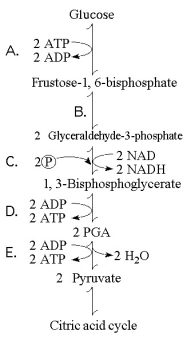Multiple Choice
Refer to Figure 9.1 to answer the following questions.
Figure 9.1 illustrates some of the steps (reactions) of glycolysis in their proper sequence. Each step is lettered. Use these letters to answer the questions.

-A molecule that is phosphorylated
A) has been reduced as a result of a redox reaction involving the loss of an inorganic phosphate.
B) has a decreased chemical reactivity; it is less likely to provide energy for cellular work.
C) has been oxidized as a result of a redox reaction involving the gain of an inorganic phosphate.
D) has an increased chemical reactivity; it is primed to do cellular work.
E) has less energy than before its phosphorylation and therefore less energy for cellular work.
Correct Answer:

Verified
Correct Answer:
Verified
Q8: Why is glycolysis described as having an
Q10: Figure 9.3 <img src="https://d2lvgg3v3hfg70.cloudfront.net/TB2680/.jpg" alt="Figure 9.3
Q11: The primary role of oxygen in cellular
Q11: Figure 9.3 <img src="https://d2lvgg3v3hfg70.cloudfront.net/TB2680/.jpg" alt="Figure 9.3
Q13: Refer to Figure 9.1 to answer the
Q14: Figure 9.3 <img src="https://d2lvgg3v3hfg70.cloudfront.net/TB2680/.jpg" alt="Figure 9.3
Q18: In the presence of oxygen, the three-carbon
Q24: Which metabolic pathway is common to both
Q46: During cellular respiration, acetyl CoA accumulates in
Q71: The ATP made during glycolysis is generated